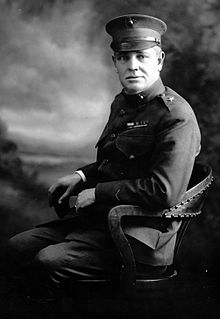Albertus W. Catlin
| Albertus Wright Catlin | |
|---|---|

|
|
| Born |
December 1, 1868 Gowanda, New York |
| Died | May 31, 1933 (aged 64) Culpeper, Virginia |
| Place of burial | Arlington National Cemetery |
| Allegiance |
|
| Service/branch |
|
| Years of service | 1886–1892 (Navy) 1892–1919 (Marine Corps) |
| Rank |
|
| Commands held |
3rd Marine Regiment Marine Corps Base Quantico 6th Marine Regiment |
| Battles/wars |
Spanish–American War Vera Cruz (1914) World War I *Battle of Belleau Wood |
| Awards |
Medal of Honor Legion of Honour Croix de Guerre (2) |
Brigadier General Albertus Wright Catlin of the United States Marine Corps (December 1, 1868 – May 31, 1933) after commanding the 3rd Regiment at Veracruz, Mexico, in 1914, was issued a commendatory letter by the Secretary of the Navy for courage and skill in leading his command. Later, he received the Medal of Honor for bravery in action.
Born December 1, 1868, in Gowanda, New York, Catlin was appointed to the U.S. Naval Academy from Minnesota in May 1886. He captained the football team at Annapolis and played left halfback for three years. After graduating with the Class of 1890, he served on board USS Charleston for required two years sea duty as a Midshipman.
The Marines seemed to offer the best chance for active service, so Catlin applied for and was commissioned a second lieutenant in the Marine Corps on July 1, 1892. In September 1892 he reported for duty at the Marine Corps School of Application and graduated first in his class in April 1893. In April 1893, Catlin was promoted to First Lieutenant and transferred that December to Marine Barracks, League Island, Philadelphia Navy Yard, Pennsylvania. Returning to sea in August 1895, he reported to USS Cincinnati.
Catlin then transferred to USS Maine and was in command of her Marine Detachment when the ship was destroyed in Havana Harbor in February 1898. During the Spanish–American War that followed, he served aboard the auxiliary cruiser St. Louis, which participated in the blockade of the harbor at Santiago de Cuba, and led a group of Marines and Sailors in an attempt to cut the undersea telegraph cable linking Cuba with Jamaica.
...
Wikipedia

